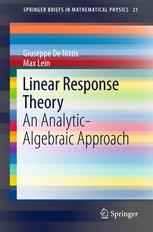

Most ebook files are in PDF format, so you can easily read them using various software such as Foxit Reader or directly on the Google Chrome browser.
Some ebook files are released by publishers in other formats such as .awz, .mobi, .epub, .fb2, etc. You may need to install specific software to read these formats on mobile/PC, such as Calibre.
Please read the tutorial at this link: https://ebookbell.com/faq
We offer FREE conversion to the popular formats you request; however, this may take some time. Therefore, right after payment, please email us, and we will try to provide the service as quickly as possible.
For some exceptional file formats or broken links (if any), please refrain from opening any disputes. Instead, email us first, and we will try to assist within a maximum of 6 hours.
EbookBell Team

5.0
40 reviewsThis book presents a modern and systematic approach to Linear Response Theory (LRT) by combining analytic and algebraic ideas. LRT is a tool to study systems that are driven out of equilibrium by external perturbations. In particular the reader is provided with a new and robust tool to implement LRT for a wide array of systems. The proposed formalism in fact applies to periodic and random systems in the discrete and the continuum. After a short introduction describing the structure of the book, its aim and motivation, the basic elements of the theory are presented in chapter 2. The mathematical framework of the theory is outlined in chapters 3–5: the relevant von Neumann algebras, noncommutative $L^p$- and Sobolev spaces are introduced; their construction is then made explicit for common physical systems; the notion of isopectral perturbations and the associated dynamics are studied. Chapter 6 is dedicated to the main results, proofs of the Kubo and Kubo-Streda formulas. The book closes with a chapter about possible future developments and applications of the theory to periodic light conductors.
The book addresses a wide audience of mathematical physicists, focusing on the conceptual aspects rather than technical details and making algebraic methods accessible to analysts.